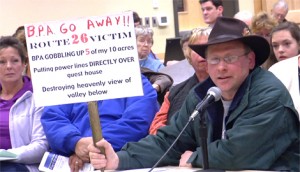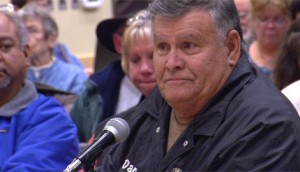An often testy crowd of nearly 300 packed the Battle Ground Community Center last Thursday to oppose the Bonneville Power Administration’s (BPA) plan to construct a 70-mile, 500-kilovolt transmission line through Clark County.
The project has been a source of controversy ever since it was announced to the public in 2009. BPA is a not-for-profit federal agency that provides 75 percent of the high voltage transmission in the Pacific Northwest. It says it wants the line to guarantee a stable power supply moving into the future. The line will link two future substations at Castle Rock to the north and Troutdale, Ore. to the south.
The public fight has been about all the land in between.
BPA is currently considering four alternative routes with a price tag of between $317 and $407 million. The cheapest choice is a western route that would utilize an existing right of way that passes through densely populated neighborhoods in Vancouver, while three other routes veer through the center or eastern part of the county in less populated land.
Draft environmental statement delayed, home owners left in limbo
BPA project manager Mark Korsness told the audience that the agency decided to delay the release of a draft environmental statement – which had been due this month – until next spring to gather more public input and to complete more studies.
“We’re dedicated to taking this process through to the end so that we don’t keep you people hanging any longer than we need to,” he said.
However, in the meantime, property owners say they are in a state of limbo.
Retiree Dan Clark of Castle Rock said he and his wife, Janet, bought 67 acres of property to fulfill a dream of building a campground for families. However, all that is on hold because one of the alternative BPA routes goes straight down the middle of his property.
Clark can’t sell the land and doesn’t dare build on it.
“If you’re going to do this, tell us,” Clark said, choking up, “because I don’t have that much time to live. You’re using up my time.”
Eyesores and fears of electric and magnetic fields
What has made the 500-kilovolt line so controversial is that it requires massive towers, stretching 15 stories tall with 150-foot clearance on either side. In wooded areas, the structures require the removal of trees and vegetation, plus the construction of access roads. In cities, the towers are considered eyesores that can lower property values for those living nearby.
But the more ominous concern repeated by speakers was the potential health risk of the electric and magnetic fields (EMF) the powerful lines generate. BPA says studies are inconclusive whether the amount of EMF the 500-kilovolt lines produce is harmful to humans, but that hasn’t been good enough for critics.
Three citizen groups – Another Way BPA, Citizens Against the Towers, and the Yale Valley Coalition – have rallied behind the issue. They want the lines located as far away from populated areas as possible.

A choir of children, led by Nicole Karalekas (right), sing a song urging the BPA not to put transmission lines near neighborhoods or schools.
Audience members gave a standing ovation to a group of children from Brush Prairie, Wash. who sang a song urging BPA not to place the towers near neighborhoods or schools. The song included the verse, “Our children our most vulnerable. Their health will be at stake. I can’t imagine why this is a choice that one would make.”
Later during public testimony, speaker Jane Fielding described how her disabled son has an implant that sends electrical impulses to his brain to stop seizures. She fears EMF will disrupt its operation.
“I can’t imagine what will happen when now, all of a sudden, he’s living in this kind of a magnetic field,” she said.
BPA excludes uninhabited federal timberland option
Another Way BPA spokesperson Terry Constance thinks he has figured out a route that will avoid people altogether. He has mapped out a so-called “grey line” that would extend to the eastern edge of Clark County and run along mostly uninhabited federal timberland. The grey line isn’t currently on BPA’s list, however.
“The grey line impacts the least number of people,” Constance said. “You have to consider it. It’s got to be in the draft.”
Rural property owners stand up to protect their land
On the other side of the issue are rural property owners – clearly a minority in the room – who say their right to protect their land must also be considered. Cheryl Brantley, a board member for the organization A Better Way for BPA, argues that BPA can’t justify the added cost of constructing the line in rural lands when it already has access to an existing right of way.
“At a time when our country and its citizens are struggling financially, we believe no governmental entity should needlessly spend more on new land when it can build on the land it already owns the rights to,” she said.
Tree farmer Peter T. Revesz, 82, and his wife Jane operate four farms in Clark County. Each one stands to be impacted by at least one of three BPA routes, as well as the unofficial grey line. Revesz said that family-owned farms are part of the economic backbone of the county and can’t be overlooked.
“For gosh sakes, please protect private free enterprise, which is the small forest landowner,” he said.
Audience loses patience
BPA’s Mark Korsness, who sat stoically throughout the proceedings, closed the meeting by thanking the audience for coming. However, when he attempted to reiterate BPA’s decision to build the transmission lines to meet future power demands, he was interrupted by a burst of jeers and shouts of “lies.”
“I understand it’s taking longer than you would like, but we are dedicated to moving this process along as quickly as we can,” he concluded.











